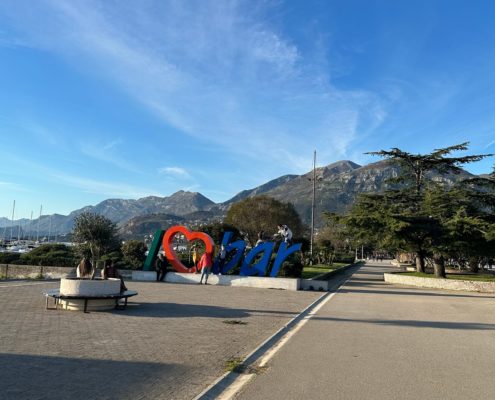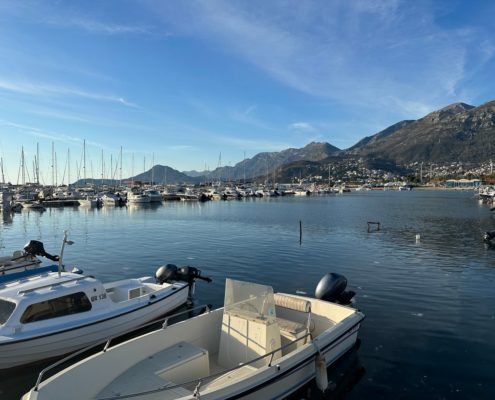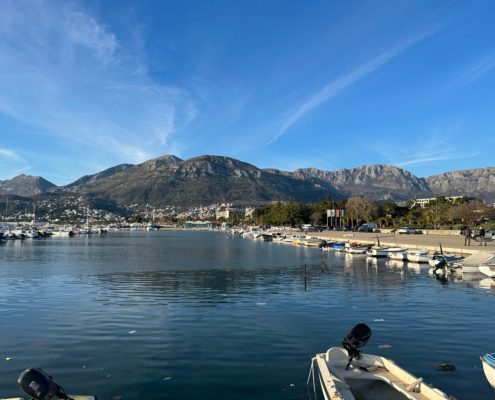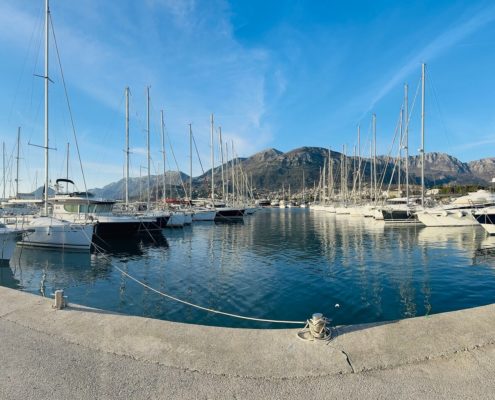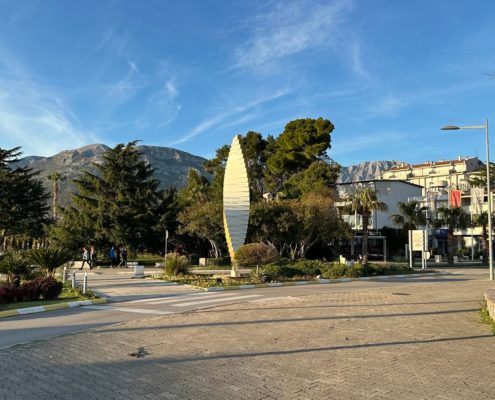The almost 40,000 inhabitants of Bar make the city the largest port city in Montenegro.
Today the city is divided in two: directly on the Adriatic coast is Novi Bar (“the new bar”) with a huge port. At first glance, with its large deep-sea port and tank farms, it is not touristy at all. Nevertheless, Bar with the cargo port and its huge freighters, the imposing yachts and the small colorful fishing boats is worth a stroll. Also interesting is the earlier futuristic Robna kuća shopping mall from the socialist era.
For a port city, Bar is surprisingly clean and lots of green space combined with the sea breeze create a pleasant and relaxed atmosphere. You can even swim on the beach of Šušanj. Other beaches in the area are in the neighboring towns of Sutomore and Canj, but it can get very crowded here, especially on weekends.
Bar has benefited economically in the past as the start and end point of the railway line to Belgrade and as an existing cargo port. In the meantime, however, only the ferry and loading operations have remained from the maritime tradition. The waterway to Bari and Ancona in Italy is still used today. Daily and bi-weekly ferries go to Bar.
Bar is also the terminus of the spectacular railway connection via Podgorica to Belgrade, which was opened in 1974 after 24 years of construction and winds its way through the mountains of Montenegro with the help of countless bridges and tunnels. From Bar the railway leads to Virpazar on Lake Skadar – this was the first railway line in Montenegro in 1908.
King Nikola’s Palace “Veliko Dvorac” still towers over the harbor promenade. The beautiful, sunny yellow building was built in 1885 directly on the sea. Firstly, King Nikola was a keen sailor and secondly, he was so comfortable in welcoming state guests arriving by sea. Today it houses the Municipal Museum of Local History, where you can learn more about the history and development of the city and the Montenegrin dynasty (with photos, archaeological finds, historical clothing, royal furniture and rural implements). The garden of the royal residence is also worth a look. Plants thrive in it that Montenegro’s seafarers brought to the country from all over the world.
The other part – “Stari Bar” (“the old Bar”) is located about 4 km kilometers inland at the foot of the Rumija Mountains. The ancient city was founded more than 2,000 years ago, had 4,000 inhabitants at its peak and magnificent buildings by various rulers. The monumental city walls and the Basilica of St. George, the Romanesque Church of St. Mark, St. Catherine, the Great Aqueduct and the Bishop’s Palace are still preserved, as are the remains of the Ottoman Empire (including the Turkish baths). Some of the ruins also testify to the war between Montenegro and the Ottoman Empire (1877).
In the meantime, many buildings have been restored, so that Stari Bar is once again the tourist center of the city and is one of the most valuable cultural and historical sites in Montenegro.(After the earthquake in 1979, Stari Bar was abandoned and “the new bar” was rebuilt right on the coast.)
In Bar there is the old Mirovica olive tree, which is one of the oldest specimens in the region with an age of about 2300 years and is said to still bear fruit! It is signposted as “Stara Maslina” and can be reached from the road to Ulcinj. You can admire it for a small fee.
The olive trees are a symbol of Bar and their high-quality oil is offered at sometimes very high prices. Olive oil from Bar can be found all over Montenegro and, despite its higher price, it is extremely popular due to its excellent taste and environmentally friendly production. Speaking of olives: between Bar and Ulcinj there are more than 100,000 olive trees! It is still extracted today using old stone mills and refined with garlic. This specialty is a must when visiting Montenegro. From Bar there are trips to the hinterland, such as trips to Lake Skadar or the Bay of Kotor. Or a rafting tour in the Tara Canyon.
This post is also available in: German

